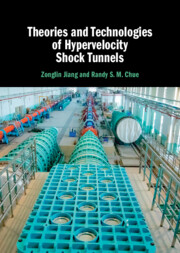Book contents
- Theories and Technologies of Hypervelocity Shock Tunnels
- Theories and Technologies of Hypervelocity Shock Tunnels
- Copyright page
- Contents
- Preface
- 1 Introduction
- 2 Shock-Wave Relations and Aerothermodynamic States
- 3 Heated Light-Gas High-Enthalpy Shock Tunnels
- 4 Free-Piston-Driven High-Enthalpy Shock Tunnels
- 5 Detonation-Driven High-Enthalpy Shock Tunnels
- 6 Theory and Methods for Long-Test-Duration Shock Tunnels
- 7 Methods for Designing High-Enthalpy Flow Nozzles
- 8 Aerothermodynamic Testing and Hypersonic Physics
- Index
- References
8 - Aerothermodynamic Testing and Hypersonic Physics
- Theories and Technologies of Hypervelocity Shock Tunnels
- Theories and Technologies of Hypervelocity Shock Tunnels
- Copyright page
- Contents
- Preface
- 1 Introduction
- 2 Shock-Wave Relations and Aerothermodynamic States
- 3 Heated Light-Gas High-Enthalpy Shock Tunnels
- 4 Free-Piston-Driven High-Enthalpy Shock Tunnels
- 5 Detonation-Driven High-Enthalpy Shock Tunnels
- 6 Theory and Methods for Long-Test-Duration Shock Tunnels
- 7 Methods for Designing High-Enthalpy Flow Nozzles
- 8 Aerothermodynamic Testing and Hypersonic Physics
- Index
- References
Summary
The surrounding air flow around a hypersonic vehicle behaves quite differently from supersonic flows. The kinetic energy is converted into internal energy which can increase the flow temperature and induce endothermic reactions near the vehicle surface. It is a challenge to develop flow diagnostic and aerodynamic measurement technologies with high precision for high-enthalpy wind tunnel tests. There are, generally, three types of measurement technologies widely used in exploring high-enthalpy flows, including heat-transfer measurement, aerodynamic balance, and optical diagnostic techniques. In this chapter, hypersonic tests with the aforementioned measurement technologies are summarized to demonstrate the progress on high-enthalpy flow experiments. Four kinds of experiments are included here, and the topics are aerodynamic force and moment tests, aerothermal heating measurements, hypersonic boundary-layer flow diagnostics, and supersonic combustion and scramjet engine tests. Actually, there are a lot of interesting topics, but these four are important not only to understand aerothermodynamic physics but also to support the development of hypersonic vehicles.
Keywords
- Type
- Chapter
- Information
- Theories and Technologies of Hypervelocity Shock Tunnels , pp. 236 - 297Publisher: Cambridge University PressPrint publication year: 2023



